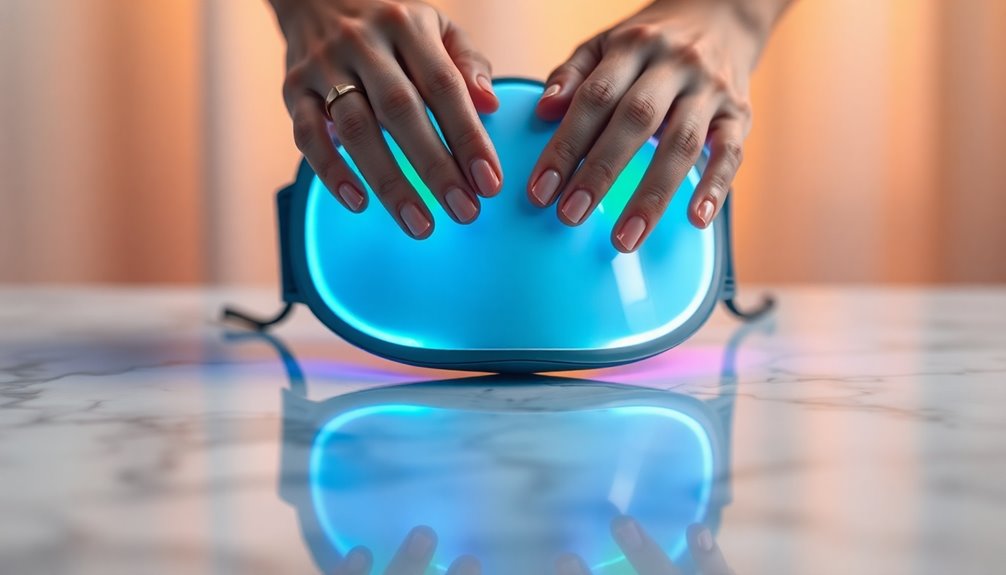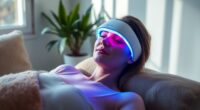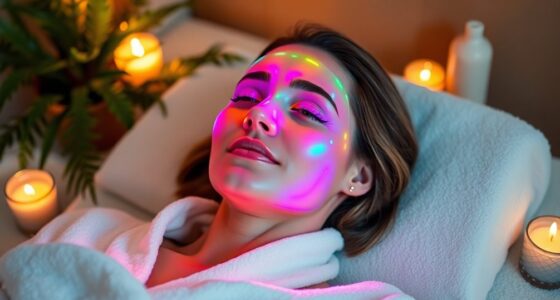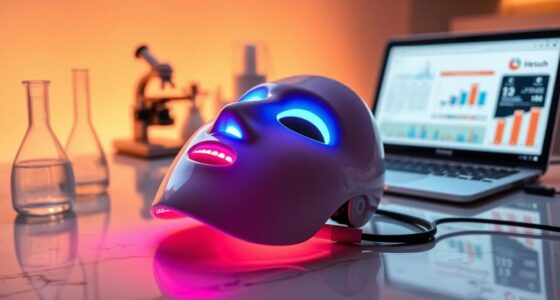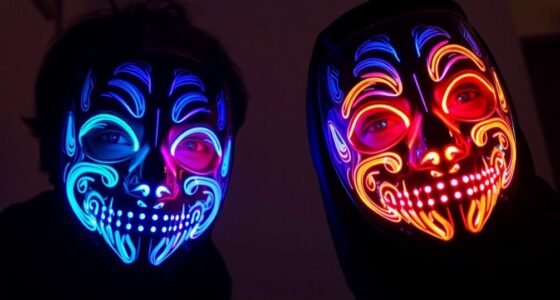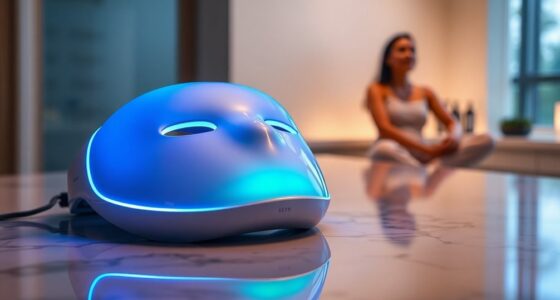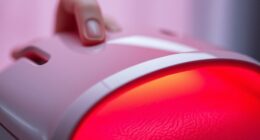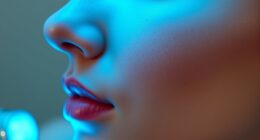LED masks are generally safe for skincare use, but you need to be cautious with their application. Make sure to wear blackout goggles for eye protection and limit your session durations to avoid irritation. Skin reactions, though mild, can occur if you don’t follow usage guidelines properly. It’s wise to consult a dermatologist if you have sensitive skin or specific concerns. To learn about potential side effects and how to use these masks effectively, keep checking for more info!
Key Takeaways
- LED masks are generally safe for use, but eye protection, such as blackout goggles, is crucial to prevent harm from light exposure.
- Prolonged use can lead to skin irritation; following manufacturer guidelines on session length is essential to avoid adverse effects.
- Consultation with a healthcare professional is recommended for those with existing eye disorders or skin sensitivities.
- Choosing FDA-cleared devices ensures safety and effectiveness, as they meet specific regulatory standards for at-home use.
- Mild side effects like dryness may occur; it’s important to monitor skin changes and seek advice from a dermatologist if needed.
Understanding LED Masks
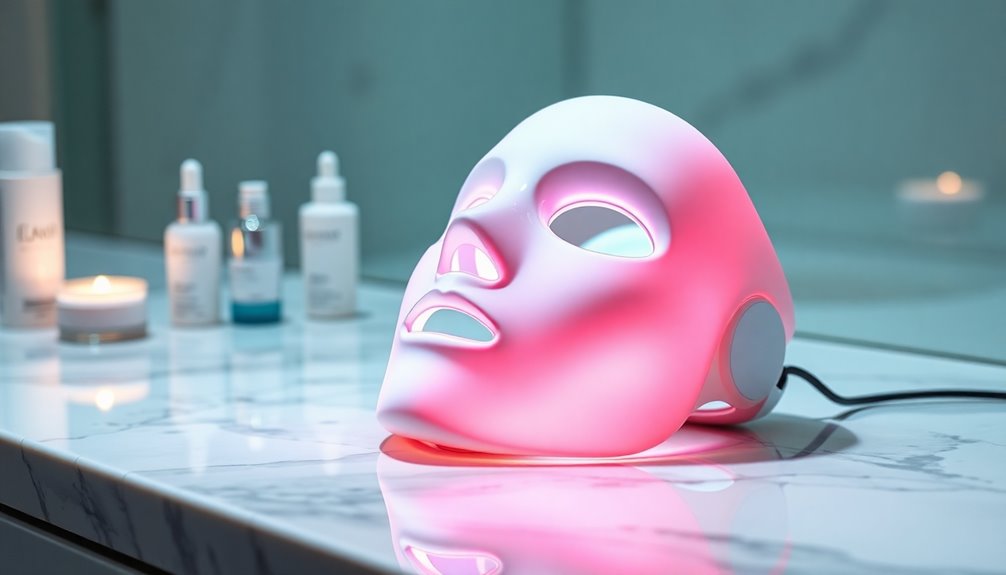
When it comes to skincare technology, LED masks have gained popularity for their ability to address various skin concerns. These devices use different light wavelengths, including blue light, to target issues like acne and aging.
However, if you have light sensitivity or specific eye conditions, you should exercise caution. Always prioritize eye protection during treatments, especially with blue light, to prevent discomfort or potential injuries.
Although most LED masks are designed to avoid direct eye exposure, be mindful of any spillover light that could pose risks. Following manufacturer guidelines on usage time is essential for short-term safety, but keep in mind that long-term effects are less understood.
Consulting a dermatologist is advisable if you’re uncertain about using LED masks.
Safety Concerns of LED Masks
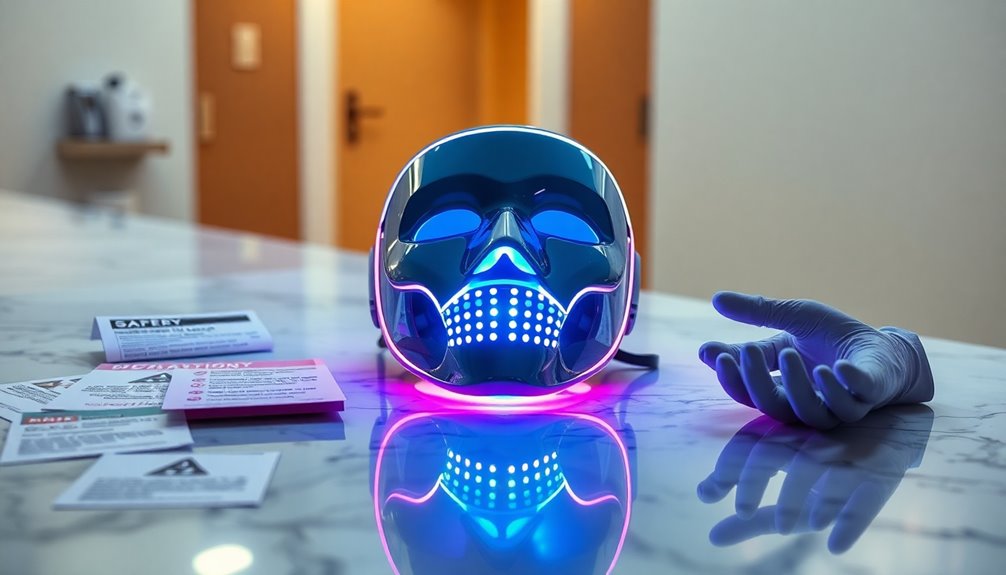
How safe are LED masks for your skin? While generally considered safe, there are important safety concerns you should keep in mind.
Follow these safety precautions to protect yourself:
- Eye Protection: Always wear blackout goggles during treatment to shield your eyes from harmful light, especially with blue light.
- Prolonged Exposure: Limit your sessions and avoid excessive use to reduce the risk of eye injuries and adverse skin reactions.
- Consult a Professional: If you have existing eye disorders, consult a healthcare professional before using LED masks to guarantee your safety.
Remember to adhere to manufacturer guidelines and stay vigilant about any skin changes.
Potential Side Effects
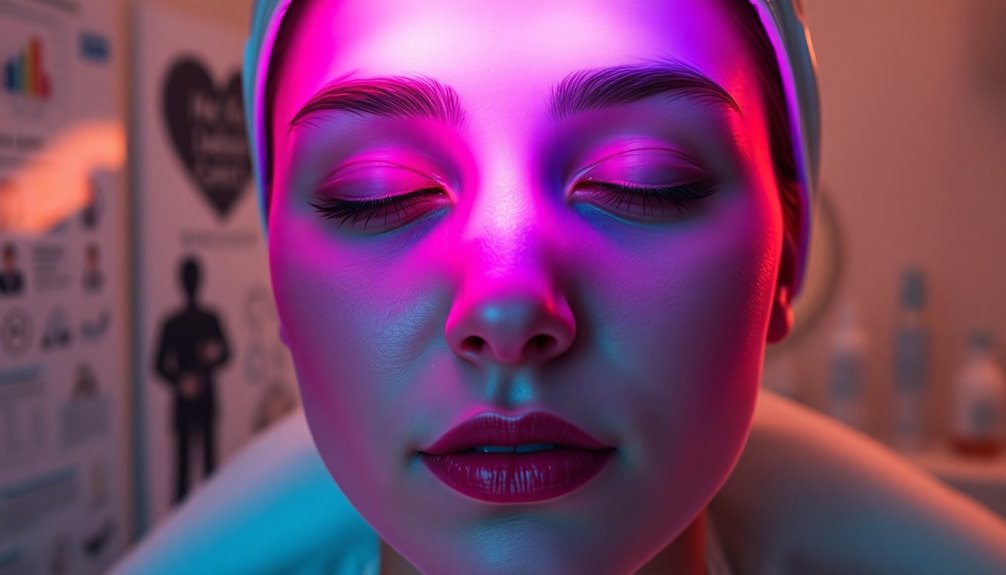
When using LED masks, you need to be aware of potential skin irritation and the importance of eye protection.
If you don’t wear proper eye shields, prolonged exposure to certain lights can lead to serious eye issues.
Always listen to your skin and consult a dermatologist if you’re concerned about sensitivity or irritation.
Eye Protection Importance
Although LED masks offer various skin benefits, eye protection is essential to prevent potential side effects. Prolonged exposure to blue light can lead to serious issues, including:
- Vision Problems – Extended exposure may cause lasting damage to your eyesight.
- Eye Irritation – You might experience discomfort or pain if your eyes aren’t adequately shielded.
- Increased Risks – Individuals with certain eye disorders should consult a dermatologist before use.
The Neutrogena Light Therapy Acne Mask recall emphasizes the necessity of safety measures.
Always wear blackout or opaque goggles during treatment sessions to protect your eyes from spillover light.
Skin Irritation Risks
While LED masks can provide various skin benefits, they also carry the risk of skin irritation, particularly if you don’t follow the manufacturer’s guidelines. Overusing these devices may lead to increased inflammation or rashes, especially for those with sensitive skin or pre-existing conditions.
You might notice mild side effects like dryness or discomfort after treatment. It’s important to moderate your sessions to avoid these issues.
Additionally, don’t forget that eye protection is vital during LED therapy. Prolonged exposure to certain wavelengths, especially blue light, can cause visual disturbances or eye pain.
To minimize risks, consult with a dermatologist before starting LED therapy, particularly if you have specific skin concerns that could heighten the possibility of adverse reactions.
Eye Safety Precautions
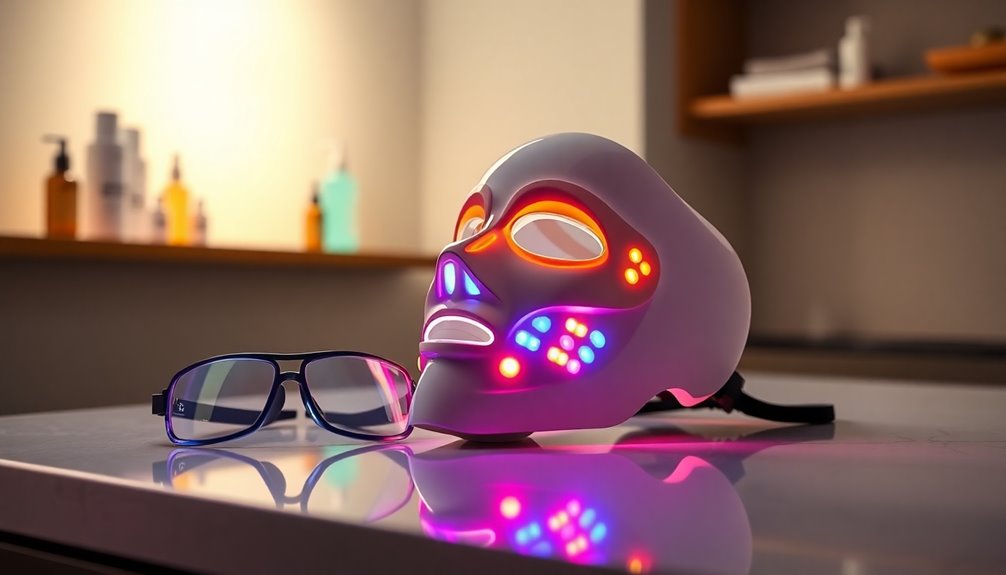
Guaranteeing eye safety during LED mask treatments is crucial, especially with blue light, which can lead to issues like blurry vision or discomfort.
To protect your eyes, remember these key precautions:
- Use blackout goggles: These shield your eyes from spillover light, reducing the risk of prolonged exposure effects.
- Follow manufacturer instructions: Always adhere to the guidelines provided for your specific LED mask to guarantee proper eye protection.
- Consult a professional: If you have any existing eye disorders, it’s critical to seek advice before using LED masks, as you may face heightened risks.
Recommendations for Safe Use
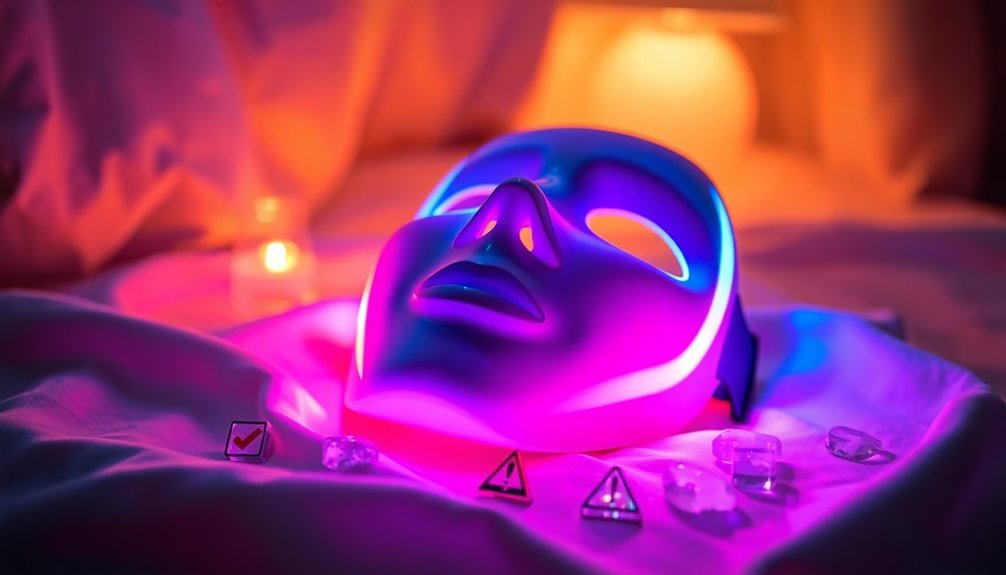
When using LED masks, eye protection is a must, so make certain to wear blackout goggles to shield your eyes from harmful light.
You should also stick to the manufacturer’s instructions on usage time to prevent overexposure.
Finally, always opt for FDA-cleared devices to guarantee safety and minimize risks.
Eye Protection Essential
How can you effectively protect your eyes during LED mask treatments? Eye protection is vital, especially with devices emitting blue light, which can cause eye injury if not adequately shielded.
To guarantee your safety, consider these recommendations:
- Use blackout or opaque goggles: These prevent potential damage from spillover light during treatment sessions.
- Limit prolonged exposure: Avoid extended sessions to reduce the risk of blurry vision and eye pain.
- Assess existing eye disorders: Certain conditions may heighten the risks associated with LED exposure, so individual evaluation is essential.
Follow Manufacturer Instructions
Following the manufacturer’s instructions is essential for a safe and effective LED mask experience. Always read the guidelines regarding usage time and frequency to avoid potential side effects like irritation or redness.
Make certain your LED light therapy mask is FDA approved to guarantee it meets safety standards. During treatment, use blackout or opaque goggles to protect your eyes, especially when using blue light, which can pose risks to eye health.
Don’t exceed the recommended treatment duration, as prolonged exposure may lead to increased inflammation or discomfort. If you have any underlying skin concerns, it’s wise to consult with a dermatologist before starting LED mask therapy to confirm it’s suitable for your needs.
Choose FDA-Cleared Devices
Choosing an LED mask that’s FDA-cleared is essential for ensuring your safety and the effectiveness of your treatment. These devices have undergone rigorous evaluations and are generally safe for at-home use.
To maximize safety while using LED masks, keep these tips in mind:
- Always follow the manufacturer’s instructions regarding usage time and frequency to prevent adverse effects.
- Use protective eyewear, like blackout goggles, to shield your eyes from potential damage during treatment.
- Consult with a dermatologist beforehand, especially if you have existing skin sensitivities or eye conditions.
Who Should Avoid LED Masks?
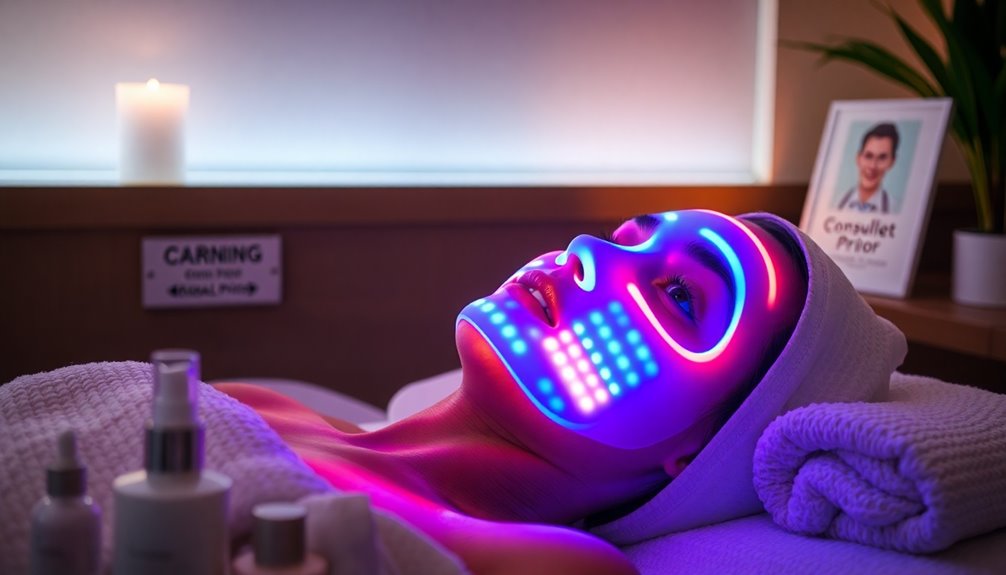
While LED masks can offer numerous skin benefits, certain individuals should steer clear of them to guarantee their safety.
If you’re under 18, it’s wise to avoid LED masks due to limited research on their effects on younger skin. Pregnant or breastfeeding women should also refrain, as the impact of light therapy during these times isn’t well understood.
Additionally, if you have specific eye conditions, like retinal disorders or severe light sensitivity, consult a dermatologist before using LED masks to avoid potential eye damage.
Those with active skin conditions or inflammation, such as eczema or psoriasis, may find their symptoms worsen.
Ultimately, wait until your skin fully heals after recent skin treatments before trying LED masks to prevent irritation.
Comparing At-Home and Professional Treatments
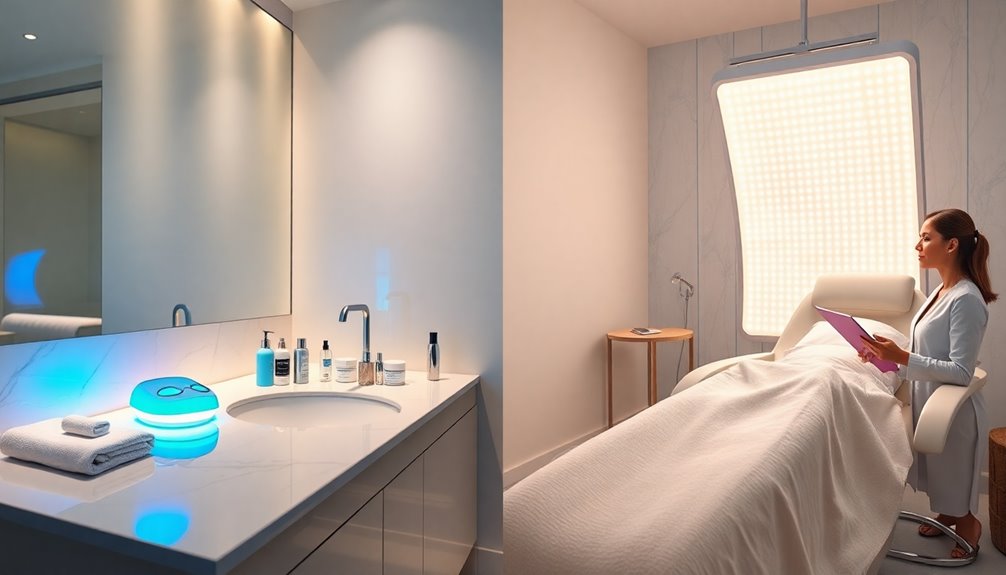
For those evaluating LED masks, understanding the differences between at-home options and professional treatments is key to making an informed choice. Here are three key aspects to reflect on:
- Efficacy: Clinical studies show that professional treatments lead to significant improvements, while at-home LED devices provide more subtle results, requiring consistent use for noticeable benefits.
- Cost: At-home devices are often budget-friendly, ranging from under $50 to nearly $2,000, while professional sessions cost between $150 and $300 each.
- Collagen Stimulation: Professional treatments utilize advanced technology with multiple wavelengths, enhancing collagen stimulation in a controlled environment.
While at-home LED masks can be safe in the short term, achieving ideal results often depends on your frequency of use and commitment to a routine. For those seeking significant improvements in skin tone and texture, daily use of LED masks can be particularly beneficial. Incorporating them into your skincare regimen not only enhances their effectiveness but also helps maintain consistent results over time. However, it’s essential to follow the manufacturer’s guidelines to ensure optimal safety and performance.
Regulatory Standards and FDA Approval
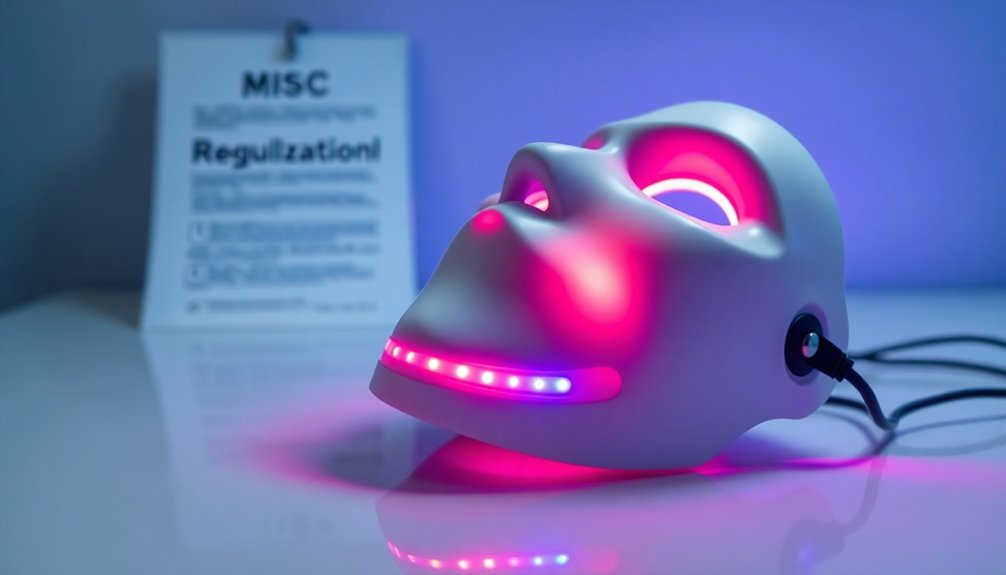
When considering LED masks, it’s crucial to be aware of their regulatory standards and FDA approval status.
FDA-cleared devices have met specific safety standards for at-home use, guaranteeing they demonstrate safety and effectiveness through scientific evidence. The FDA evaluates these light therapy devices based on their intended use and potential risks.
Many reputable LED masks include design features to avoid direct eye exposure and minimize risks associated with prolonged usage. To safeguard your safety, always follow the manufacturer guidelines and usage instructions provided.
Be cautious, as the recall of some products, like Neutrogena’s Light Therapy Acne Mask, underscores the importance of regulatory oversight in addressing potential safety concerns.
Expert Opinions on Safety

Experts emphasize that using FDA-cleared LED masks is essential for guaranteeing safety and efficacy.
When considering LED therapy, keep these points in mind:
- Eye Protection: Always wear protective eyewear, especially during blue light treatments, to prevent potential injuries or discomfort.
- Consult a Dermatologist: If you have specific skin concerns, consulting a dermatologist before starting LED mask treatments is important for tailored advice.
- Follow Manufacturer Guidelines: Adhering to the manufacturer’s instructions guarantees safe use of at-home devices and minimizes risks.
While most LED masks are designed to avoid direct eye exposure, caution is still necessary.
Frequently Asked Questions
What Is the Risk of LED Face Mask?
When using an LED face mask, you should be aware of several risks.
Prolonged exposure without proper eye protection can lead to discomfort or vision problems. If you have light sensitivity or specific eye conditions, it’s essential to consult a dermatologist before use.
Overusing the mask may cause irritation, redness, or inflammation.
Always follow the manufacturer’s guidelines and take precautions to prevent any unintended light exposure, especially during longer treatment sessions.
What Are the Disadvantages of LED Light Therapy Masks?
When considering LED light therapy masks, you should be aware of several disadvantages.
They can be pricey, often exceeding $1,000, which is a significant investment.
Battery life may be short, requiring frequent recharges.
If you’re a beginner, some masks aren’t user-friendly, leading to improper use and less effective results.
Additionally, mixed reviews on effectiveness for specific skin concerns mean you mightn’t achieve the results you’re hoping for.
Always prioritize caution during use.
Who Shouldn’t Use a LED Mask?
Did you know that nearly 25% of people using skincare devices experience irritation?
If you’re considering an LED mask, you should know it’s not for everyone. If you’re under 18, pregnant, breastfeeding, or have specific eye disorders, it’s best to skip it.
People with active skin conditions like eczema or recent cosmetic procedures should also avoid LED therapy.
Always consult a dermatologist if you’re unsure about your skin’s response to these treatments.
What Are the Issues With LED Face Masks?
When using LED face masks, be aware of potential issues like eye injury from prolonged blue light exposure.
You might experience irritation or redness if you overuse the masks, so it’s essential to follow the manufacturer’s guidelines.
Additionally, if you have certain eye disorders, you could face heightened risks.
Always consult a dermatologist before starting treatment to guarantee it’s suitable for your skin and eye health.
Your safety should come first!
Conclusion
In summary, while LED masks can be a bright addition to your skincare routine, it’s essential to prioritize safety. By following guidelines and considering any personal health concerns, you can illuminate your path to healthier skin without worry. Remember, just like a compass guides a traveler, informed choices lead to the best results. So, if you’re ready to glow, make sure you’re doing it the right way!
